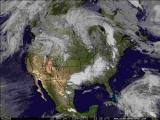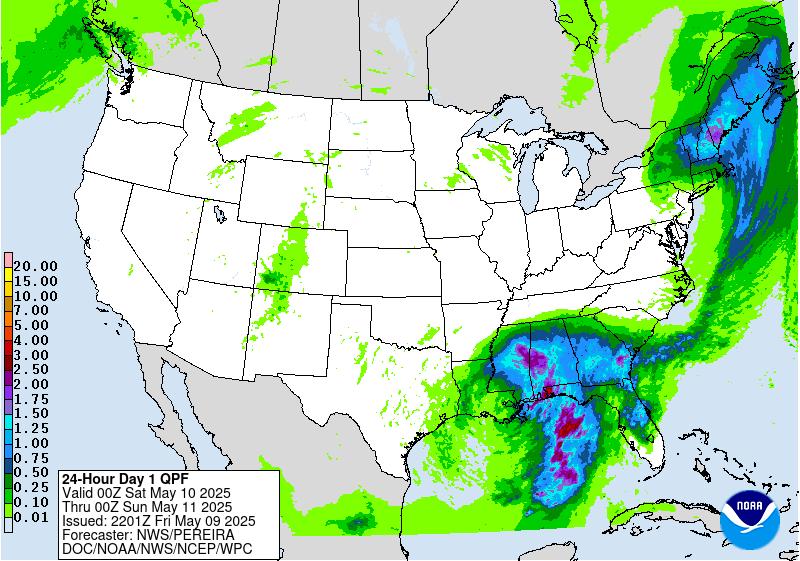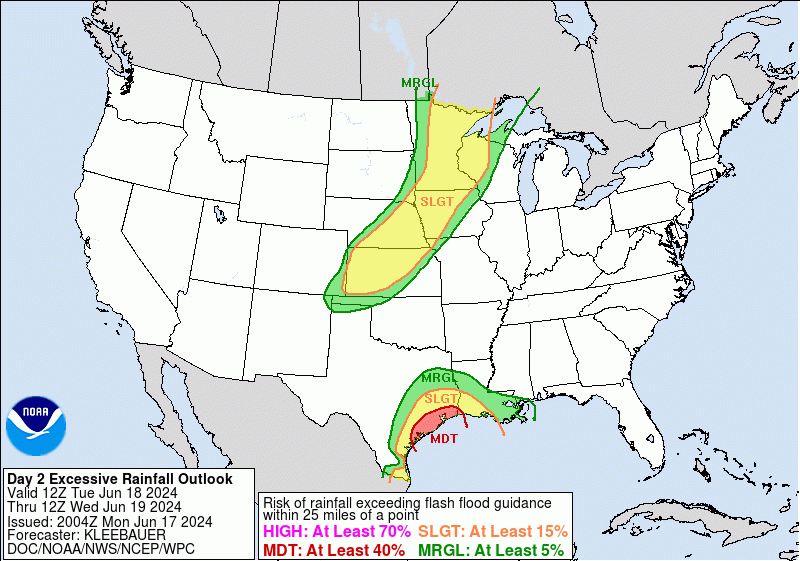Excessive Rainfall Discussion
NWS Weather Prediction Center College Park MD
857 PM EDT Thu May 16 2024
Day 2
Valid 12Z Fri May 17 2024 - 12Z Sat May 18 2024
...THERE IS A MODERATE RISK OF EXCESSIVE RAINFALL FOR PORTIONS OF
THE LOWER MISSISSIPPI VALLEY INTO SOUTHERN AND CENTRAL ALABAMA...
...20Z Update...
Recent trends in guidance have shifted the heaviest axis of precip
for the D2 period a bit further south with the corridor extending
from I-55 in LA to the northeast through southern MS/AL into central
AL as the primary focus for heavy precip and flash flooding
potential Friday into Saturday. The area encompassed by the new MDT
orientation is the region most likely to be impacted by both the
remnant complex from the west that will move through the early
portion of the period, as well as the shortwave perturbation
ejecting out of the western Gulf into the Gulf Coast the second
half of the forecast. The latter is the period of interest with
regards to highest impacts with the current moisture flux anomalies
based within the latest NAEFS Climatological data set indicating
the low to mid-level moisture field reaching the 99th percentile
relative to climo across southeastern LA through parts of the Deep
South. With a strong mid-level vorticity maxima added to the
synoptic picture, this historically is favorable for widespread
convective initiation with a heavy QPF footprint given the
anomalous deep layer moisture field.
Probabilistically, the trends are slowly becoming more favorable
for the aforementioned area with the most daunting signal coming
from the 12z HREF neighborhood probability for at least 5" of
rainfall running between 35-45%, now centered over southern MS with
some probs of 20% dotted over parts of southeast LA through
southern AL. The 12z HREF EAS probabilities paint another picture
with very high probs for at least 1" of precip across much of the
Deep South, but a precipitous drop off once you move to 2" and 3"
with values more in-line around 10-20% which relays some of the
uncertainty in the eventual evolution of the pattern and the
expected heavy rain output. The environment will remain very
favorable for locally heavy rainfall with the region fairly
saturated from previous events, leading to lower than normal FFG
indices to exceed. This is one of the main reasons for the MDT
potential, and the rest becomes correlated to the expected multi-
round threat of convection during the beginning of Friday and
eventual impacts Friday night into early Saturday. After assessing
the mean QPF output and probability fields, as well as coordination
with the offices involved across the Southeast, we were able to
tighten the bounds of the Moderate Risk area and surrounding SLGT
as the pattern likely focuses in-of where the best instability
aligns with the flow running parallel to the frontal boundary
across the southeast. Mesoscale evolution pertaining to remnant
outflows from early convection will likely have a say on the,
"Where" the heaviest precip will occur as convection focuses along
those convergent zones. That will be contingent on short term
assessment, so there could be further shifts in the risk areas with
climo-based trends likely leaning towards a more southerly
adjustment in the higher-end potential. As of now, the MDT risk
extended from portions of southeast LA up through southern MS/AL to
south of Birmingham. SLGT risk extends back through Houston and
points northeast into west-central GA.
The second SLGT risk across portions of the Ohio Valley was
maintained given continuity in recent guidance for some scattered
heavy thunderstorms promoting local totals of 1-2" with locally
higher through the morning and afternoon hours Friday.
Kleebauer
...Previous Discussion...
By the start of the period 12Z Friday, the ongoing showers and
thunderstorms from the Day 1 period will be moving across the Day 2
Moderate risk area already. This first batch will quickly move off
to the north and east into central Alabama and Georgia through the
day, with occasional showers and storms following behind it.
The front that moved the LLJ advecting the impressive Gulf moisture
into the southern US will stall out across Louisiana, Mississippi,
and Alabama by Friday morning. With the LLJ no longer moving, the
low level southwesterly flow will align with the 90 kt upper level
jet streak. This will increase the potential for training storms,
if fast-moving, across the Moderate and surrounding Slight Risk
areas. Once the first batch of storms moves through in the morning,
there will be a relative break for much of the afternoon. However,
weak shortwave impulses tracking parallel to the jet streak may
still allow for occasional waves of storms to track across the
Moderate Risk area through the day.
Late Friday afternoon into the evening, the approach of a final and
strongest shortwave will reach the Slight and Moderate risk areas,
resulting in a "blossoming" of convection into the region. With
continued very high PWATs and instability, the storms will remain
capable of producing rates as high as 2 inches per hour, locally
higher with the strongest storms. Multiple rounds of storms are
likely through Friday night, which will result in storm total
rainfall through early Saturday morning of 2-4 inches with local
totals to 6 inches. The strongest and most prolific rain-makers are
expected during the predawn hours Saturday as the aforementioned
strongest upper level shortwave moves northeast across the Slight
and Moderate Risk areas.
Soils in this area are also quite saturated from recent heavy
rainfall, so it's expected that most of the rainfall through
Saturday morning will convert to runoff, resulting in scattered
instances of flash flooding with locally considerable flash
flooding.
In coordination with JAN/Jackson, MS; BMX/Birmingham, AL; and
MOB/Mobile, AL forecast offices, the Moderate Risk was expanded
northward into Birmingham and southward into Mobile, AL with this
update.
...Mississippi and Ohio Confluence Region...
Little has changed in the forecast for this region. A secondary
shortwave trough on the northern side of the jet stream will take
some of the Gulf moisture streaming in from the south and support
convection across the area. This convection will likely be ongoing
at the start of the period Friday morning, with any resultant flash
flooding starting soon thereafter. The storms will be capable of 1
inch per hour rainfall rates. Recent heavy rainfall along the Ohio
and Mississippi Rivers in this region have locally saturated the
soils, and additional rainfall amounts of 1 to locally 2 inches of
rain from morning convection may result in widely scattered
instances of flash flooding.
Wegman
|






















































































